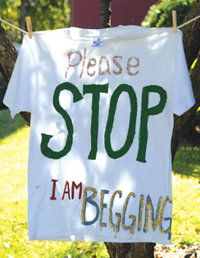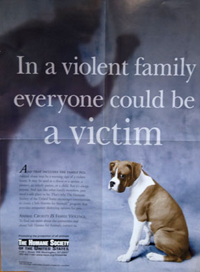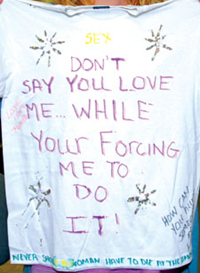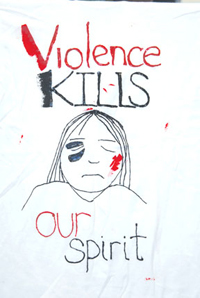A History of Domestic Violence
- and Those Fighting it on the Front Lines
By Mary Elizabeth Fratini

In 1973, domestic violence didn't even have a name, let alone a legal identity. Sexual assault within a marriage was legal - it was not considered rape if the assailant and the victim were spouses. Temporary restraining orders were only available to victims filing for divorce - leaving parents, unmarried partners, the elderly, and lesbians who were unwilling to press criminal charges without protection. There were no shelters anywhere in Vermont, no hotlines, no task forces, no network.
In little over a decade, however, a small but fervently dedicated cadre of women across Vermont had established a hotline and access to a shelter or safehouse in each of the state's 14 counties.
Jeri Martinez recalled that in 1977, when she began working as a secretary for Vermont Legal Aid, a statewide non-profit law firm, "I had never heard the words 'battered' and 'woman' put together before." Martinez, herself a survivor of domestic violence, remained at Vermont Legal Aid for the next 14 years as a paralegal and training director, intimately involved with the organization's pioneering efforts to identify and create legal remedies for the silent social scourge of sexual and domestic violence.
"What keeps me going in this work is one victim I remember from Legal Aid. A priest brought her in on Monday. She was beaten up on Saturday night and he found her crying and hiding in the bushes at the church. He took her in until we opened on Monday so that she had a place to stay, because back then we knew of a few safe homes, but that was it," Martinez recalled. "I think of her and how different it is now, and of course I'm optimistic. I've seen this change in attitude that is incredible - so inspiring."
In the Beginning
The first battered women's program in Vermont opened in Burlington as a hotline in 1974, offering members' homes as safe houses for two years until opening a shelter for battered women and children in 1976. A second domestic violence program, Umbrella, also opened in St. Johnsbury, training 17 women to assist rape survivors in Caledonia and Essex counties as part of a women's rape crisis team in 1977.

Martinez got involved domestic violence advocacy, she says, because "the lawyers didn't understand it - they would come out after meeting with a battered woman and say, 'she's just going to go back, she must like it.' And I knew in my heart, god knows I didn't like it."
Those misconceptions about domestic violence permeated every level of government and were perpetuated by citizens of both genders. In 1977, the New Hampshire State Commission on the Status of Women turned down a proposal to shelter battered wives, with one commissioner noting that "those women libbers irritate the hell out of their husbands." The same year, however, Vermont's Commission on Women (known then as the Governor's Commission on Women), appointed a task force to study domestic violence and received a grant to open a second shelter, the Women's Crisis Center in Brattleboro.
In the next two years, safehouse networks or shelters were established to serve women and children in Rutland, Franklin, Washington, Orange, and Addison counties. In addition, therapists Michael Hartman and Barry Rufenacht founded Delta, the state's first batterer intervention program (see related story, page 26).
In 1979, three legislators, including then-Representative Jim Douglas (R-Middlebury), introduced H.401. Drafted by Jack Wesley, the lobbyist for Vermont Legal Aid, the bill as introduced removed the divorce requirement and expanded eligibility for protection orders to include spouses, former spouses, and household members; required defendants to provide temporary spousal and child support; made violating a protection order a misdemeanor punishable by one year in jail or a $1000 fine, or both; and required police to use "all reasonable means to prevent further abuse," including explaining a victim's rights under and providing a written explanation of her rights under both the bill and criminal law.
The bill was passed the following year as the Vermont Abuse Prevention Act, but with amendments restricting eligibility for protection orders to married and divorced victims, and without making violating protection orders a crime, giving police authority to enforce APOs or requiring financial compensation. Although it would take another two decades for all the rights enumerated in the original draft to become law, it was a giant first step. "I was there for the House's final passage of the bill and I've never forgotten that day," Martinez recalled. "I sat in the gallery and just cried. It was wonderful."

Growing Awareness Meets Growing Need
The 1980s brought increasing awareness of the depth and breadth of domestic violence in Vermont at many levels of government, including the Legislature and law enforcement. In 1981, the Legislature appropriated $30,000 of state funding for domestic violence programs for the first time. In 1982, they more than doubled the appropriation to $65,000, and raised it almost every year thereafter, reaching a high of almost $947,000 in 1996.
The number of women and children served by the growing number of domestic violence agencies has continued to grow apace with the appropriations, however. From July of 1981 to June of 1982, they helped 2,545 battered women and children. One year later, that number jumped to more than 4,500 women and children; by 2006 programs within the Vermont Network Against Domestic Violence and Sexual Assault (formed in 1986) served more than 10,200 people.
In 1981 Vermont's fourth shelter opened, the Clarina Howard Nichols Center in Morrisville, as did domestic violence agencies serving Orleans, Windsor, and Bennington counties. And in 1985, amendments to the Abuse Prevention Act finally made violating a protection order punishable by criminal contempt and gave police authority to arrest without warrant when they had probable cause to believe a person had committed a misdemeanor involving an assault against a family or household member. A statutory amendment redefining sexual assault also made marital rape a crime for the first time in Vermont's history by removing the provision requiring that a rapist and victim be unmarried.
In 1988, Vermont Legal Aid sponsored the first statewide domestic violence training, focusing on the ongoing amendments to the Abuse Prevention Act, for its staff, awareness advocates, and members of the bar. Other professional trainings followed, sponsored by Legal Aid and other organizations, for police, social workers, judges, and medical professionals.

"Once they see behind the facade of domestic violence to what is really going on, people are very empathetic," said Martinez, who worked with a variety of groups for Vermont Legal Aid and, later, the Network. "It is important to do that, because people often look at battered women and say, 'Well, she didn't protect her child,' and totally ignore the fact that she can't protect herself. It has been my mission throughout to end that, to stop the blame. I know that it is part of the baggage people carry in to every group I teach - why doesn't she just leave? For a percentage of women, when they leave, he follows, he attacks, and the violence can escalate to the point of murder."
Unfortunately, it took a series of such instances - murders of women by abusive former partners - to move legislative efforts on domestic violence to the forefront in the 1990s. After participating in prosecuting her abusive ex-boyfriend Robert Mayo for rape and reckless endangerment, Cynthia Thow was murdered by Mayo, who was free on bail, in 1990. Just three days before her death, newspapers reported, Thow had asked her landlady, "Do I have to let him kill me before they lock him up?"
"It is sad, but when Cynthia Thow died, one of my co-trainers [who was a police officer] called me and said, 'Now is the time because this will hit the papers tomorrow,' and he was so right," recalled Martinez. Thow was murdered on January 29; by May, legislation passed that made violating a protection order a crime. Other bills following in the wake of Thow's murder included the establishment of a Victim's Compensation program and a law providing victims of crimes the right to request notification before a perpetrator is released or when he escapes.
The stalking and murder of Judith Hart Fournier in September of 1992 and the abduction and murder of 21-year-old Diane Young Waterman by her abusive, estranged husband Gerald Waterman in October spurred the Legislature into passing a five-section bill introduced by Senators Susan Sweeter and Peter Shumlin creating the crimes of domestic assault and stalking, revising the definition of "serious bodily injury," and making the punishment for attempts to murder and rape punishable by the same penalties as the crimes themselves.
That all three of these women - Thow, Hart Fournier, and Young Waterman - were murdered by batterers free on bail led to the consideration of a Constitutional Amendment empowering judges to deny bail to violent felony offenders. The latter ran into objections from civil libertarians, however, including the ACLU-VT, whose lobbyist testified at the time that violence against women perpetrated by released batterers and rapists was "part of the price society has to pay for freedom," according to Martinez.
Some judges displayed a similarly cavalier attitude towards the price society continued to exact from battered women simply for being battered. In 1990, the Vermont Supreme Court reversed a decision by Judge Arthur O'Dea, later removed from the bench by the Legislature, in the divorce case of Blair v. Blair, because remarks in O'Dea's decision inappropriately discredited the victim's testimony about domestic violence. O'Dea's decision read in part: "We do recognize that there was a certain amount of misbehavior; that there may be these temper tantrums and items of misbehavior, but the strangling with the hands and violence and threats that were described by Karen have been blown way out of proportion as evidenced by the fact that she stayed throughout the four years of marriage."
Martinez also recalled another instance in 1993 when a State's Attorney was prosecuting a man accused of beating his wife and killing a neighborhood dog. "He said, 'Your honor, we have here today a man accused of two crimes: beating his wife and killing a neighborhood dog. I'm asking a sentence of one to three months for beating his wife-and six to twelve months for killing the dog. After all, your honor, we all know how confusing these domestics are-and in this case, the dog was totally innocent,'" she recalled.
A Brief Turn on the Federal Red Carpet
In 1993, Vermont became the first state to train all of its law enforcement officers on domestic violence, thanks to a grant from the U.S. Justice Department jointly administered by the Vermont Police Academy, the Department of Public Safety, and Martinez. Teams of domestic violence advocates and officers provided 54 domestic violence training sessions for all 1,600 of Vermont's certified police officers.
"To this day, when I run into officers and introduce myself, they say, 'I remember you from the training,'" Martinez said. "Some of them kept their manuals and have given them to family members who are survivors so they can understand domestic violence."
The focus of the training was the commonalities between police and domestic violence victims. "They both face danger and confront it with a ladder of force to deescalate the violence," Martinez explained. "I always say that no one can understand the life of a battered woman better than a cop, and vice versa. Even the results are the same - problems with the heart and digestive system, post-traumatic stress, depression. We both make a decision on the spur of the moment, in danger, that people second-guess - for police, it is juries, and for battered women, everyone judges what you did or didn't do. Helping to see that we have so much in common made a huge difference."
Following his election to the presidency, Bill Clinton, the son of a battered woman, increased the emphasis on, and funding for, domestic violence awareness through the Violence Against Women Act (VAWA). In 1996, Vermont became one of only 12 states to pass its own legislation authorizing the same protections of VAWA at the state level.
Sarah Kenney, now public policy director for the Network, first got involved with domestic violence advocacy around this time as a volunteer for the Women's Rape Crisis Center in Burlington. "I actually came to the issue of domestic violence through working with women who had been sexually assaulted by a partner. When I became the public policy coordinator in 2002, ... one of the first things I learned was that the two issues [sexual assault and domestic violence] are inextricably linked, and that although some of the specific services may look different, survivors of violence against women share so much in common," she said.
The glamour of domestic violence advocacy was short-lived, however, agree Martinez and State Representative Mark Larson (D-Burlington). Larson began working as a facilitator in treatment groups for men who batter in 1992. "The passage of VAWA and the money associated with it brought a lot of focus to domestic violence. It has [been] felt for the past few years that domestic violence has gone out of favor for many," Larson wrote in an email. "Given the complexity of domestic violence, this is not a surprise. It is not an issue that lends itself to simple or convenient solutions and this can frustrate people."
Kenney agreed: "Between funding cuts at the federal level, increasing costs, and an ever-increasing demand for the services provided by our Member Programs, domestic and sexual violence victim service organizations are constantly struggling to make ends meet." Virtually every advocate, she says, lists cash assistance as "the number one thing the Legislature could do for individual survivors."
The cash is needed not just by the advocacy organizations but by the victims themselves. Kenney explains that, "because economic abuse is such an incredibly common - and effective - tactic of batterers, many of the people who seek help are facing real economic peril. We as a society have created an untenable situation where women are sometimes forced to choose between living with violence and living in poverty."
Growing Pains?
Aside from funding, domestic violence advocacy is facing some tough internal conversations about the future of the movement, including the appropriate role for men and gender-neutral language about domestic violence.
Martinez is particularly irked by a push for gender-neutral language in family court. "Isn't it interesting that in district court there is no problem using the male pronoun for everything, but all of a sudden it's 'Let's make sure that in family court we are gender-neutral?" she said. "Men commit 80 percent of the crimes, [and] they are anywhere from 80-90 percent of batterers, that we know of. Why should we be gender-neutral about a problem that is gendered? Men are victims as well, but domestic violence is far from being a genderless problem."
"I find that many people want to downplay the understanding of domestic violence as men's violence against women and make it more gender-neutral," agreed Larson. "I think the most important thing that men can do is be role models of respectful relationships with women for boys and other men. We need to build cultural norms that foster respect and safety and challenge sexism and violence."
Larson is one of a handful of men in Vermont who have been deeply involved in anti-domestic violence work for many years, and he noted a paucity of opportunities for men to remain active in activities confronting men who are violent. "One of the challenges is that there are few opportunities to educate and mentor men to be leaders in efforts against male violence directed at women. We simply don't have many places where men can contribute, learn, and explore their own process of developing an anti-sexist identity," he said.
Martinez and Kenney are supportive of more men speaking out against domestic violence, and both recognize the inherent tension in bringing men into a movement begun by, and for, women. "I think it is hard for men not to be the heads of things, but I think their place in the movement is support, like it is for all of us when we are speaking for a larger group," Martinez said. "Some people will say that is sexist, but it is important to me that lay women speak for us, because most of the people needing services are lay women."
"The most effective male advocates and educators I've seen have been very careful to take their lead from women in the movement and to do their best to keep survivors' needs at the heart of their work," Kenney said. "I definitely see a very clear role for men in holding other men accountable. The longer I do this work, the more it becomes painfully clear that the issue of violence against women will never be solved exclusively by women. Since men are perpetrating the vast majority of crimes of violence against women, it will take men's participation in order to end the violence."
In their vision for the next three decades of domestic violence advocacy, however, Martinez, Larson and Kenney are united in supporting education, of everyone in every conceivable capacity.
"I would like to see a two-pronged approach - one focusing on providing survivors with all the supports they need and another focused on comprehensive, community-wide prevention work," Kenney said. "We still have a long way to go in terms of making sure that every survivor of domestic violence is believed, supported, and has access to all the services and opportunities that she needs to protect herself and her children and to rebuild their lives."
"We need to do more training with everyone," agreed Martinez. "You can't just do it once, you've got to keep it going because that is what changes attitudes. You make change a person at a time, and here in Vermont, a person at a time is noticeable."
"I am a big advocate of training," Larson wrote. "I believe that in many cases what needs to happen right now is not the development of new services but a renewed focus on existing training systems so that we get better results."
"I think about what has been done to convince people to stop smoking in the U.S. over the past 30 years," Larson continued. "Just think what could happen if we have a similar long-term commitment to challenging the underlying social supports for domestic violence and male violence against women. Then we would be getting somewhere."
"If you put the last 4,000 years into a single calendar year, you see that until December 27, it was okay to beat women," noted Martinez. "In the last three days of that year, it has become unacceptable. We did that - this movement did that - and we can do the rest."
Assistant Editor Mary Fratini lives in Barre. She can be reached at maryfrat@vermontwoman.com.
|

